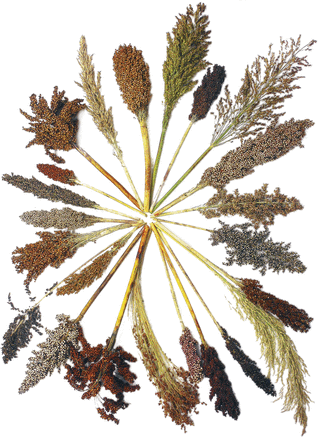- Molecular Markers for Genetic Diversity Studies in African Leafy Vegetables. Not surprisingly, only 3% of 33 studies since 1998 are on Cleome, more than half on cowpea. And a quarter used RAPDs. Orphan crops, anyone? These one don’t even get a table summarizing and comparing findings across species.
- Conservation priorities of Iberoamerican pig breeds and their ancestors based on microsatellite information. Depending on how you crunch the genetic numbers, Iberoamerican pig breeds could conceivably best be looked after by conserving their ancestral Iberian pig breeds. But it’s not just about the genetics, is it?
- Native fruit tree genetic resources in Japan. Only a Castanea was domesticated in pre-modern times, and they’re all endangered in post-modern times.
- Perceptual selection and the unconscious selection of ‘volunteer’ seedlings in clonally propagated crops: an example with African cassava (Manihot esculenta Crantz) using ethnobotany and population genetics. It’s seedlings that look most like existing varieties that farmers try to keep.
- Changes in sunflower breeding over the last fifty years. From yield under optimal conditions to disease resistance, from oil quantity to quality. But international collaboration still needed.
- Angolan vegetable crops have unique genotypes of potential value for future breeding programmes. Unique material documented, and hopefully made available for use.
- Maize Germplasm Conservation in Southern California’s Urban Gardens: Introduced Diversity Beyond ex situ and in situ Management. Migrants bring along their crops.
- An assessment of the conservation status of Mesoamerican crop species and their wild relatives in light of climate change. Priority areas for on farm and in situ conservation don’t by and large coincide with protected areas.
- A Proposal Regarding Best Practices for Validating the Identity of Genetic Stocks and the Effects of Genetic Variants. Just do it.
NIbbles: ABS, CWR editorial, Wheat nutrients, Pepper history, Gene flow, Seed consolidation
- How can communities benefit from the commercialization of indigenous products?
- How can be best conserve crop wild relatives?
- How can breeders breed better pasta wheat?
- How did Europe end up using the wrong pepper?
- How can we monitor the escape of cultivated genes into the wild?
- How will seed industry consolidation affect diversity?
Brainfood: IPR in breeding, Cryo costs, Undervalued spp, Biodiversity change drivers, Cassava proteins, Sorghum seed sources
- ‘Do Not Privatize the Giant’s Shoulders’: Rethinking Patents in Plant Breeding. “Toll roads, not road blocks.”
- Implementation and cost analysis of a regional farm animal cryobank: an Italian case study. 2497 semen doses from 46 donor animals from 5 breeds cost €1550 annually, 83% for liquid nitrogen.
- Opportunities for Underutilised Crops in Southern Africa’s Post–2015 Development Agenda. Good for marginal land, good for nutritional diversity. But still not properly valued.
- Agricultural Management and Climatic Change Are the Major Drivers of Biodiversity Change in the UK. The first negatively, the second with mixed results. What about CWR specifically?
- Domestication Syndrome Is Investigated by Proteomic Analysis between Cultivated Cassava (Manihot esculenta Crantz) and Its Wild Relatives. The leaf and root proteins of two cassava cultivars were different from those of one wild accession. More work needed, methinks.
- Interhousehold variability and its effects on seed circulation networks: a case study from northern Cameroon. Wealthy households have access to more diverse sorghum seed sources.
Measuring the elements of sorghum
There’s a great photo on the cover of Plant Physiology this month.

The paper in question looks at the “ionome” of sorghum seeds. That’s a new one on me too. It’s the genes responsible for the accumulation of different elements in whatever tissue. The authors measured the levels of a whole suite of elements in the seeds of a carefully chosen set of very diverse, and equally carefully genotyped, sorghum accessions representing all races. By comparing phenotype with genoptype, they identified gene variants associated with high levels of zinc, manganese, nickel, calcium, and cadmium. Now breeders interested in biofortification know what to include in their crossing programs.
Brainfood: Oxygen and seeds, Chicken inbreeding, Non-IPR seed laws, Biodiversity & farm management, Soil agrobiodiversity, Biodiversity & plant protection double, Genebank conservation value, Dichotomies
- Barley seed ageing: genetics behind the dry elevated pressure of oxygen ageing and moist controlled deterioration. There’s seed ageing and seed ageing, genetically speaking.
- Estimates of effective population size and inbreeding in South African indigenous chicken populations: implications for the conservation of unique genetic resources. “Conservation flocks” aren’t working.
- Seed laws, certification and standardization: outlawing informal seed systems in the Global South. The Man uses more than just IPR.
- Farmland biodiversity and agricultural management on 237 farms in 13 European and 2 African regions. The more agriculture, the less biodiversity…
- An Underground Revolution: Biodiversity and Soil Ecological Engineering for Agricultural Sustainability. …but you can do something about it…
- Warming and fertilization alter the dilution effect of host diversity on disease severity. …and this is why you should: plant diversity means better protection against pests and diseases.
- Multi-country evidence that crop diversification promotes ecological intensification of agriculture. No, really.
- Assessing the conservation value of ex situ seed bank collections of endangered wild plants. It’s not just the number of species.
- Biotechnology or organic? Extensive or intensive? Global or local? A critical review of potential pathways to resolve the global food crisis. “…no single pathway will work in every situation.”